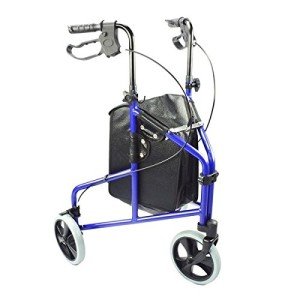mobility-aid9926
mobility-aid9926
What’s The Job Market For Handicap Walker Professionals Like?

Understanding Handicap Walkers: Types, Benefits, and Usage
Handicap walkers, also commonly known as mobility walkers or merely walkers, serve as essential aids for people with mobility challenges. These devices supply physical support and stability, allowing users to walk more confidently and separately. This post looks into the various kinds of handicap walkers, their benefits, and essential considerations when choosing one.
What is a Handicap Walker?
A handicap walker is a device created to help people who have difficulty walking due to age, health problem, or impairment. Walkers help users keep their balance, prevent falls, and recover mobility. Unlike canes, which provide very little support, handicap walkers generally offer a wider base of stability, making them appropriate for more substantial mobility obstacles.
Kinds Of Handicap Walkers
Handicap walkers come in different styles, created to satisfy the distinct needs of users. Below is a breakdown of the most typical types:
| Type of Walker | Description | Suitable User |
|---|---|---|
| Requirement Walker | A lightweight frame that requires raising to move. Usually has rubber suggestions for traction. | Those who can raise the walker and have moderate balance concerns. |
| Wheeled Walker | Functions 2 wheels at the front, permitting simpler mobility without lifting. | Users who can keep stability and need more assistance while walking. |
| Rollator Walker | Similar to wheeled walkers but includes hand brakes and a seat for resting. | People requiring a portable resting option with enhanced mobility. |
| Bariatric Walker | Specifically designed for heavier people, providing enhanced frames and larger hand grips. | Heavier users requiring additional assistance and stability. |
| Child Walker | Customized designs for kids to aid in their advancement and mobility. | Kids with developmental hold-ups or mobility difficulties. |
Benefits of Using a Handicap Walker
Lots of users discover that handicap walkers considerably improve their lifestyle. Here are some benefits:
1. Increased Stability
Handicap walkers provide a sturdy assistance structure, which helps prevent falls and enhances users’ confidence when moving.
2. Enhanced Mobility
Walkers make it easier for individuals with mobility restrictions to navigate stairs, irregular surfaces, and other difficult environments.
3. Self-reliance
Utilizing a walker enables people to carry out day-to-day activities separately, whether it’s walking around your house or going shopping.
4. Pain Relief
Walkers improve posture and disperse weight more evenly, possibly minimizing discomfort in joints and muscles throughout motion.
5. Social Engagement
By assisting in mobility, walkers enable users to participate more actively in social events, household events, and neighborhood activities, cultivating a sense of belonging.
Important Considerations When Choosing a Walker
Choosing the best handicap walker is important for making sure safety and convenience. Below are crucial elements to consider:
-
User’s Height: Walkers come in different heights. It’s vital to choose one that permits the user to stand upright with a slight bend in the elbows when keeping the deals with.
-
Weight Capacity: Assess the weight capability of the walker, especially for bariatric choices, to ensure it fits the user’s requirements.
-
Mobility: If the walker will be utilized often in various locations, consider designs that can be easily folded or transported, such as rollators.
-
Features: Some walkers include additional functions like padded seats, storage baskets, and adjustable handles. Examine which functions are most advantageous for the user.
-
User Preferences: The person’s comfort and preferences ought to also play a significant function in the selection. Checking different designs might assist identify the best fit.
How to Use a Handicap Walker Effectively
Using a handicap walker properly guarantees safety and maximizes its benefits. Follow these actions for safe usage:
- Adjust the Height: Make sure the walker is changed to the correct height for the user.
- Support the Walker: Place the walker in front while ensuring all 4 rubber ideas or wheels touch with the ground.
- Use Proper Techniques: Move the walker forward about one action length, and then step into the walker while keeping the weight balanced.
- Maintain Good Posture: Stand straight and utilize the walker for assistance, not leaning exceedingly on it.
- Practice Regularly: Encourage users to practice walking with the walker frequently, assisting to construct self-confidence and enhance balance.
Frequently Asked Questions (FAQs)
1. What is the distinction in between a standard walker and a rollator?
Requirement walkers require the user to lift them with each step, while rollators have wheels and enable the user to push them forward without lifting. Rollators also normally include brakes and may have a seat.
2. Are handicap walkers covered by insurance coverage?
Coverage for handicap walkers can vary based on a person’s insurance strategy. It is advisable to talk to the service provider for particular details concerning coverage and any essential documentation needed.
3. Can kids use handicap walkers?
Yes, there are walkers developed specifically for kids that accommodate their developmental requirements. It’s important to pick a model that is age-appropriate and offers the required assistance.
4. How do I preserve my walker?
Frequently check the walker for wear and tear, including the grips and wheels. Tidy the walker as required and make sure all parts are functioning effectively for safety.
5. When is it time to stop utilizing a walker?
This differs by person. Users ought to speak with their doctor to evaluate mobility enhancements and discuss whether transitioning to a various mobility aid or moving without help is suitable.
A handicap walker can be a transformative tool for individuals with mobility obstacles, using them greater stability, independence, and boosted lifestyle. By understanding the different types, benefits, and crucial factors to consider in picking a walker, individuals can make informed choices that align with their special requirements and way of life. Whether for rehabilitation, aging gracefully, or managing specials needs, handicap walkers play an important function in promoting mobility and well-being.




